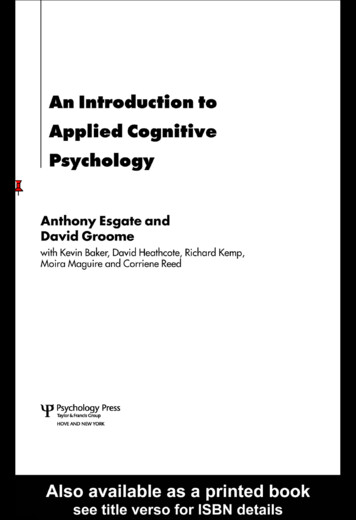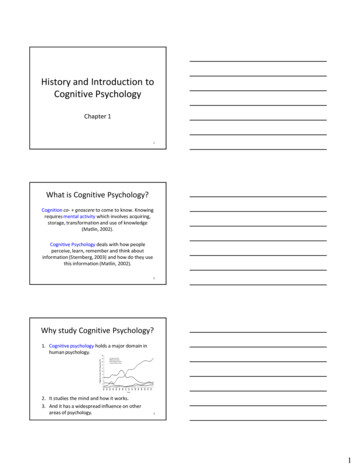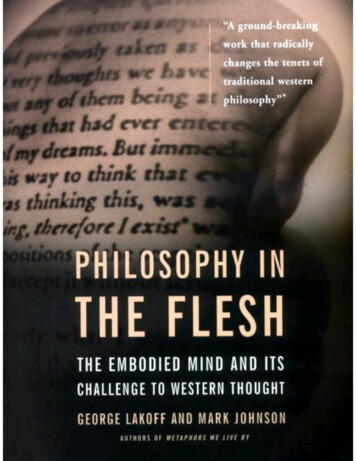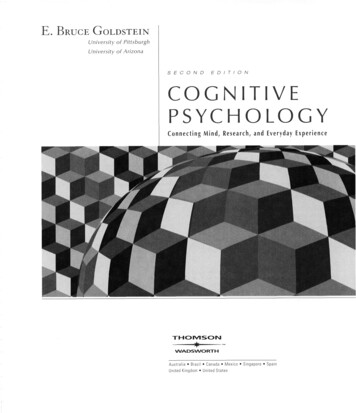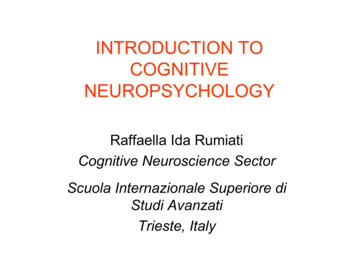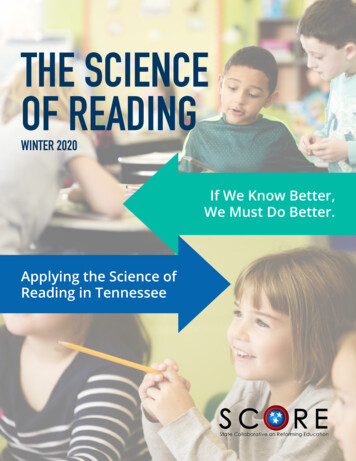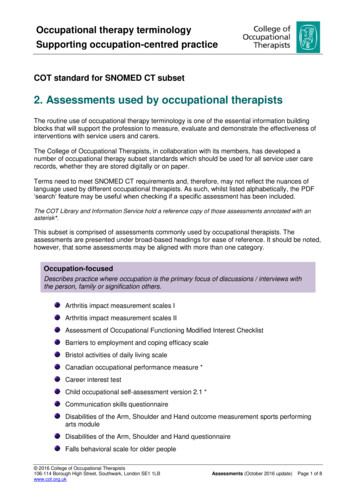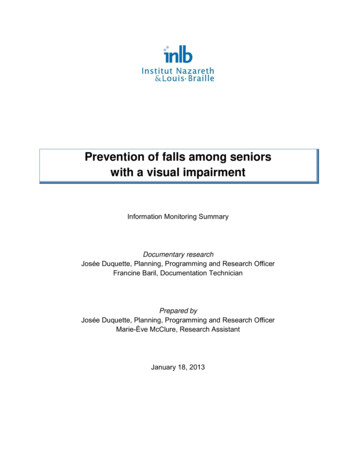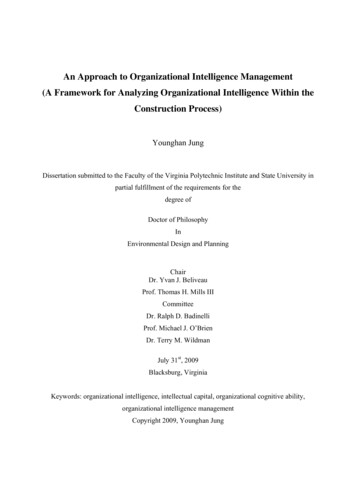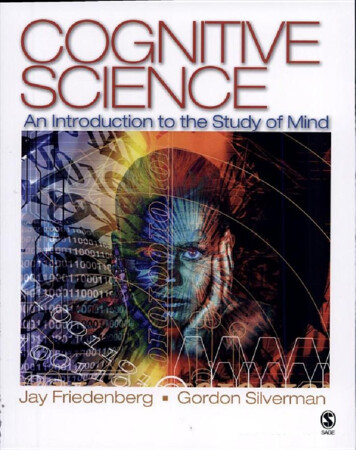
Transcription
FM-Friedenberg-4747.qxd8/22/200510:17 AMPage iCOGNITIVESCIENCE
FM-Friedenberg-4747.qxd8/22/200510:17 AMPage ii
FM-Friedenberg-4747.qxd8/22/200510:17 AMPage iiiCOGNITIVESCIENCEAn Introduction to the Study of MindJay FriedenbergManhattan CollegeGordon SilvermanManhattan College
FM-Friedenberg-4747.qxd8/22/200510:17 AMPage ivCopyright 2006 by Sage Publications, Inc.All rights reserved. No part of this book may be reproduced or utilized in any form orby any means, electronic or mechanical, including photocopying, recording, or by anyinformation storage and retrieval system, without permission in writing from thepublisher.For information:Sage Publications, Inc.2455 Teller RoadThousand Oaks, California 91320E-mail: order@sagepub.comSage Publications Ltd.1 Oliver’s Yard55 City RoadLondon EC1Y 1SPUnited KingdomSage Publications India Pvt. Ltd.B-42, Panchsheel EnclavePost Box 4109New Delhi 110 017 IndiaPrinted in the United States of America on acid-free paper.Library of Congress Cataloging-in-Publication DataFriedenberg, Jay.Cognitive science : an introduction to the study of mind / Jay Friedenberg,Gordon Silverman.p. cm.Includes bibliographical references and indexes.ISBN 1-4129-2568-1 (pbk.)1. Cognitive science—Textbooks. I. Silverman, Gordon. II. Title.BF311.F743 2006153—dc22200500952205060708Acquiring Editor:Associate Editor:Production Editor:Editorial Assistant:Typesetter:Indexer:Cover Designer:091098765Jim Brace-ThompsonMargo Beth CrouppenSanford RobinsonKaren EhrmannC&M Digitals (P) Ltd.Jeanne BusemeyerJanet Foulger4321
FM-Friedenberg-4747.qxd8/22/200510:17 AMPage vContentsPrefaceAcknowledgments1. Introduction: Exploring Inner SpaceA Brave New WorldWhat Is Cognitive Science?RepresentationDigital RepresentationsAnalog RepresentationsThe Dual-Coding HypothesisPropositional RepresentationsComputationThe Tri-Level HypothesisThe Classical and Connectionist Views of ComputationThe Interdisciplinary PerspectiveThe Philosophical ApproachThe Psychological ApproachThe Cognitive ApproachThe Neuroscience ApproachThe Network ApproachThe Evolutionary ApproachThe Linguistic ApproachThe Artificial Intelligence ApproachThe Robotics ApproachIn Depth: Categories of Mental RepresentationMinds On Exercise: Analogical 224
FM-Friedenberg-4747.qxd8/22/200510:17 AMPage vi2. The Philosophical Approach: Enduring QuestionsWhat Is Philosophy?The Mind-Body ProblemFlavors of MonismFlavors of DualismEvaluating the Dualist PerspectiveFunctionalismEvaluating the Functionalist PerspectiveThe Free Will–Determinism DebateThe Issue of DeterminismThe Issue of Free WillEvaluating the Free Will–Determinism DebateThe Knowledge Acquisition ProblemEvaluating the Knowledge Acquistion DebateThe Mystery of ConsciousnessThe What-It’s-Like ArgumentMind as an Emergent PropertyEvaluating the Emergent View of MindConsciousness and NeuroscienceConsciousness and Artificial IntelligenceOverall Evaluation of the Philosophical ApproachIn Depth: Dennett’s Multiple Drafts Theory of ConsciousnessMinds On Exercise: Decision Making3. The Psychological Approach: A Profusion of TheoriesWhat Is Psychology?Psychology and the Scientific MethodMental Atoms, Mental Molecules, and a PeriodicTable of the Mind: The Voluntarist MovementEvaluating the Voluntarist ApproachStructuralism: What the Mind IsEvaluating the Structuralist ApproachFunctionalism: What the Mind DoesEvaluating the Functionalist ApproachThe Whole Is Greater Than the Sum of Its Parts:Mental Physics and the Gestalt MovementEvaluating the Gestalt ApproachMini-Minds: Mechanism and Psychoanalytic PsychologyEvaluating the Psychoanalytic ApproachMind as a Black Box: The Behaviorist ApproachEvaluating the Behaviorist 6063656567687172737476778182848587
FM-Friedenberg-4747.qxd8/22/200510:17 AMPage viiOverall Evaluation of the Psychological ApproachIn Depth: Insight LearningMinds On Exercise: Introspection4. The Cognitive Approach I: History, Vision, and AttentionSome History First: The Rise of Cognitive PsychologyThe Cognitive Approach: Mind as an Information ProcessorModularity of MindEvaluating the Modular ApproachTheories of Vision and Pattern RecognitionTemplate Matching TheoryEvaluating Template Matching TheoryFeature Detection TheoryEvaluating Feature Detection TheoryA Computational Theory of VisionEvaluating the Computational Theoryof Pattern RecognitionFeature Integration TheoryEvaluating Feature Integration TheoryTheories of AttentionBroadbent’s Filter ModelEvaluating the Filter ModelTreisman’s Attenuation ModelThe Deutsch-Norman Memory Selection ModelThe Multimode Model of AttentionKahneman’s Capacity Model of AttentionEvaluating the Capacity Model of AttentionEvaluating the Model-Building ApproachIn Depth: Biederman’s Recognition-by-ComponentsTheory of Pattern RecognitionMinds On Exercise: Silhouettes and Object 111121131151151161161171191191201225. The Cognitive Approach II:Memory, Imagery, and Problem Solving125Types of MemorySensory MemoryWorking MemoryLong-Term MemoryMemory ModelsThe Modal ModelEvaluating the Modal Model125126127131133134135
FM-Friedenberg-4747.qxd8/22/200510:17 AMPage viiiThe ACT* ModelEvaluating the ACT* ModelThe Working Memory ModelEvaluating the Working Memory ModelVisual ImageryThe Kosslyn and Schwartz Theoryof Visual ImageryImage StructuresImage ProcessesEvaluating the Kosslyn and Schwartz TheoryThe Imagery DebateProblem SolvingThe General Problem Solver ModelEvaluating the General Problem Solver ModelThe SOAR ModelEvaluating the SOAR ModelOverall Evaluation of the Cognitive ApproachIn Depth: Search in Working MemoryMinds On Exercise: Memory Effects6. The Neuroscience Approach: Mind As BrainThe Neuroscience PerspectiveMethodology in NeuroscienceTechniques for the Study of Brain DamageEvaluating Techniques for the Studyof Brain DamageBrain Recording TechniquesComputerized Axial Tomography (CAT)Positron Emission Tomography (PET)Magnetic Resonance Imaging (MRI)The Electrical Stimulation TechniqueThe Small Picture: Neuron Anatomy and PhysiologyThe Big Picture: Brain AnatomyDirections in the Nervous SystemThe CortexThe Split BrainThe Neuroscience of Visual Object RecognitionVisual AgnosiasApperceptive AgnosiaAssociative AgnosiaFace 172173174175176177178180
FM-Friedenberg-4747.qxd8/22/200510:17 AMPage ixThe Neuroscience of AttentionModels of AttentionA Component Process ModelDistributed Network ModelsThe Neuroscience of MemoryLearning and MemoryThe Hippocampal SystemModels of Hippocampal FunctionNeural Substrates of Working MemoryEvaluating the Neuroscience of Working MemoryNeural Substrates of Long-Term MemoriesThe Neuroscience of Executive Function and Problem SolvingTheories of Executive FunctionOverall Evaluation of the Neuroscience ApproachIn Depth: Binding and Neural SynchronyMinds On Exercise: Neural Functions7. Outline: The Network Approach: Mind as a 3207The Network PerspectivePrinciples Underlying Artificial Neural NetworksCharacteristics of Artificial Neural NetworksEarly Conceptions of Neural NetworksBack Propagation and Convergent DynamicsArtificial Neural Network TypologiesEvaluating the Connectionist ApproachAdvantagesProblems and DisadvantagesSemantic Networks: Meaning in the WebCharacteristics of Semantic NetworksA Hierarchical Semantic NetworkEvaluating the Hierarchical ModelPropositional Semantic NetworksEvaluating Semantic NetworksOverall Evaluation of the Network ApproachIn Depth: NETtalkMinds On Exercise: Free 2302312332342368. The Evolutionary Approach: Change Over Time239The Evolutionary ViewEvolutionary PsychologyA Little Background: Selection239240241
FM-Friedenberg-4747.qxd8/22/200510:17 AMPage xEvolved Psychological MechanismsEvolution and Cognitive ProcessesCategorizationMemoryLogical ReasoningJudgment Under UncertaintyLanguageSex Differences in CognitionEvolutionary ComputingArtificial LifeNeural DarwinismEvaluating Evolutionary PsychologyOverall Evaluation of the Evolutionary ApproachIn Depth: A Stage Theory of EvolutionMinds On Exercise: Memory for Object 2729. The Linguistic Approach: Language and Cognitive Science275The Linguistic Approach: The Importance of LanguageThe Nature of LanguageLanguage Use in PrimatesEvaluating Language Use in PrimatesLanguage AcquisitionEvaluating Language AcquisitionLanguage DeprivationEvaluating Language DeprivationPhilosophy and Linguistics: The LinguisticRelativity HypothesisEvaluating the Linguistic Relativity HypothesisCognition and Linguistics: The Role of GrammarEvaluating Universal GrammarNeuroscience and Linguistics:The Wernicke-Geschwind ModelEvaluating the Wernicke-Geschwind ModelArtificial Intelligence and Linguistics:Natural Language ProcessingSpeech RecognitionSyntactic AnalysisSemantic AnalysisPragmatic AnalysisEvaluation of Natural Language ProcessingOverall Evaluation of the Linguistic 298299301301302303304
FM-Friedenberg-4747.qxd8/22/200510:17 AMPage xiIn Depth: The Logogen Model of Word RecognitionModern Conceptions of the LexiconMinds On Exercise: Conversational Pragmatics10. Artificial Intelligence I: Definitional PerspectiveIntroductionHistorical and Philosophical RootsThe Quest for “Mechanical Life”Philosophical Origins—Man as a MachineEvaluating Descartes’ ApproachMechanical ComputationDefining Artificial Intelligence (AI)Evaluating the Concept of AIStrong AIApplied AICognitive Simulation and NaturalLanguage CommunicationAI MethodologiesThe Computer as the Tool of AI ResearchEvaluation of the Computer as a Modelof Brain OrganizationProgrammingEvaluation of Programming LanguagesAlan Turing and the Great DebateEvaluation of the Turing Test (TT) andTuring’s DetractorsBattle Lines: The Future of the TTThe TT as an Operational Definition of AIThe TT and BehaviorismIs the TT Too Easy or Too Difficult?Overall Evaluation of the AI Concept:Summarizing the Meaning of AIIn Depth: Behaviorism and Ned BlockEvaluating the Block ApproachMinds On Exercise: Play the IG Game11. Artificial Intelligence II: Operational PerspectiveIntroductionThe Practical World of Artificial IntelligenceGoals of Practical MachinesApproaches to the Design of Intelligent 53354354356
FM-Friedenberg-4747.qxd8/22/200510:17 AMPage xiiMachine Intelligence, Knowledge,and Machine ReasoningMachine Representation of KnowledgeThe Cyc ProjectEvaluation of the Cyc ProjectObjectives of Knowledge RepresentationCharacteristics of Knowledge RepresentationKnowledge Representation TechnologiesPredicatesSemantic NetworksFramesCasesScriptsMachine ReasoningPredicate CalculusLogical Reasoning (Deduction, Abduction, Induction)Drawing InferencesInductive ReasoningEvaluation of Rule-Based ReasoningExpert SystemsExpert Systems in ActionMYCINEvaluations of Expert SystemsFuzzy LogicRepresentation of Information in the Fuzzy WorldFuzzy Logic RulesFuzzy Advice for Decision-Making or ManagementEvaluation of Fuzzy Logic SystemsArtificial Neural Nets (ANNs)Overall Evaluation of the Operational PerspectiveIn Depth: The ID3 AlgorithmMinds On Exercise: Decision Making12. Robotics: The Ultimate Intelligent AgentsIntroductionSome Robotic AchievementsEvaluating Robotic PotentialsBiological and Behavioral Foundations of Robotic ParadigmsEvaluation of the Lorenz/Tinbergen ApproachTransferring Behavioral Models to RoboticsEvaluation of the Biological Basis of 9399402404404409410411
FM-Friedenberg-4747.qxd8/22/200510:17 AMPage xiiiFoundations of Robotic ParadigmsEvaluation of Paradigm FoundationsRobotic ParadigmsHierarchical ParadigmEvaluation of the Hierarchical ParadigmThe Reactive ParadigmEvaluation of the Reactive ParadigmThe Hybrid Deliberative/Reactive ParadigmEvaluation of Hybrid ArchitecturesOverall Evaluation of Robots as Ultimate Intelligent AgentsIn Depth: Autonomous Robot Architecture (AuRA)Evaluation of AuRAMinds On Exercise: Relational Graphs13. Conclusion: Where We Go From HereThe Benefits of Cognitive ScienceWorking Memory: An Example of anIntegrated Program of StudyThe Philosophical ApproachThe Psychological ApproachThe Cognitive ApproachThe Neuroscience ApproachThe Network ApproachThe Evolutionary ApproachThe Linguistic ApproachThe Artificial Intelligence ApproachThe Robotics ApproachIssues in Cognitive ScienceA General Issue: Lack of a Single Unified TheorySpecific Issues Facing Cognitive ScienceEmotionsConsciousnessPhysical EnvironmentsSocial EnvironmentsIndividual and Cultural DifferencesEnhancing Cognitive ScienceEvaluating Cognitive Science TheoriesThe Role of IntegrationIntegration Across Levels of DescriptionIntegration Across DisciplinesIntegration Across 443444446448449449452452453454
FM-Friedenberg-4747.qxd8/22/200510:17 AMPage xivThe FutureIn Depth: Multiagent SystemsMinds On Exercise: Evaluating Theories of Mind454455457Glossary459References483Name Index505Subject Index513About the Authors531
FM-Friedenberg-4747.qxd8/22/200510:17 AMPage xvPrefaceNo single volume could hope to describe, even succinctly, the tremendousnumber of discoveries in cognitive science. We do not attempt this. Ourgoal is to give readers a solid preparatory understanding of the major theoretical contributions of each cognitive science discipline. So, rather than exhaustively catalog all possible findings, we describe the major theories of mind thathave been developed within each discipline. But what is a theory of mind? Wedefine it as a unique, organized set of ideas that teaches us how to think aboutthe mind. We also describe models of mind. Whereas a theory is general andmay not be tied to a particular process, a model is specific and details howinformation is represented and computed by a particular process.This perspective means that we focus on theories and models rather thanthe many experiments that have been conducted within cognitive science disciplines. We do not adopt the structure that is typical of textbooks in cognitivepsychology, for example, one that is ordered around detailed methodologicaldescriptions of classic experiments. We instead discuss general methods uniqueto a perspective at the outset of each chapter. Some experimental results arealso presented, but these are intended to illustrate characteristics of a particular theory or model. Experiments and method in this book are thus used toservice larger conceptual ideas of mind rather than the other way around.The Contents of the BookEach chapter (or set of chapters) is devoted entirely to a single disciplinaryapproach. These approaches include the evolutionary approach and robotics—topics not usually addressed in other texts. The general structure of eachchapter is as follows: First, an approach is described in terms of what makes itxv
FM-Friedenberg-4747.qxdxvi8/22/200510:17 AMPage xviCOGNITIVE SCIENCEspecial. The major ideas that motivate each perspective and the problems eachattempts to solve are laid out. Following this, we present factual backgroundinformation that we believe is important and describe the approach’s methodology. The bulk of each chapter is devoted to detailing the specific discipline’ssignificant theories and models of mind. Where relevant, we evaluate thetheory and outline its strengths and weaknesses. Each chapter ends with asection entitled “Overall Evaluation.” These final sections evaluate the overallcontributions of the approaches. We hope that these evaluations help studentsto realize that there is no single theory or approach that best captures what themind is about, and to think critically about these ideas on their own.Throughout there is a consistent set of topics that we touch upon. Thesetopics are the major categories of mental processes. They include visual patternor object recognition, attention, memory, imagery, and problem solving. Judgmentand reasoning are dealt with primarily from an evolutionary perspective, whilelanguage has its own chapter. In some cases, these topics are introduced in thesame order within chapters for ease of comparison. To further facilitate comparisons across chapters we have included a matrix (pp. xviii–xxii) that detailsthe primary and secondary topics, methodologies, major figures, and an evaluation summary. The matrix is a useful tool for discerning similarities and differences across disciplines.There are a number of distinctive features in this book. Every chapter concludes with supplementary material, exercises, and activities. In Depth sectionsillustrate specific theories in greater detail. The Minds On Exercises promptstudents to work on group activities that will help them to further connect withchapter content. We also present Food for Thought sections with discussionquestions drawn from material throughout the chapter. Some of these discussion questions are web questions that ask students to perform a specific activity or exercise on the Internet. Last but not least, there are lists of suggestedreadings. These readings are for the most part accessible to an introductoryaudience.Beyond the BookThe text comes with many ancillary materials. Instructor’s Resources thataccompany the book are available on CD. The disk contains chapter outlines,PowerPoint lectures, and a test bank with different question types. We alsoinclude projects for instructors. These projects again encourage in-depth exploration of selected topics. Some of the projects are web-based, others requireresearch, and all can serve as the basis of a topic for a paper. Students are able
FM-Friedenberg-4747.qxd8/22/200510:17 AMPage xviiPrefaceto access a Companion Website containing electronic flashcards of glossaryterms. The website also allows students to take practice quizzes to assess theirlevel of understanding, and provides them with links used throughout the bookand some additional sites for further exploration.xvii
logicalApproach123Chp. Name/TitleThe MatrixThe scientificmethod. Voluntarism.Structuralism.Functionalism.Gestalt thodologiesDeductive andinductivereasoning.Theory andScientific method.hypothesis.Introspection.Independent andPhenomenology.dependent variables.Experimental andcontrol groups.Stream ofconsciousness. Levelsof consciousness.Classical and operantconditioning.Monism. e.Digital and analogNo methodologiesrepresentation.discussed.The dual-codinghypothesis. Concepts.Propositions.Production rules.Declarative andprocedural chener. James.Wertheimer.Koffka. Kohler.Freud. Watson.Pavlov. Skinner.Aristotle. Plato.Berkeley.Democritus.Descartes. Ryle.Clark. Hume.Rand. Locke.Chalmers. Nagel.Jackson. Searle.Churchland.Dennett.Thagard. Paivio.Pylyshyn. Marr.Major FiguresMultiple theoreticalpositions. Firstsystematic andscientific study ofmental phenomena.Problems withintrospection andphenomenology.Provides a broadperspective. Asksfundamentalquestions. Not anempirical approach.Cognitive scienceis unique in that itbinds togetherdifferentperspectives andmethodologies inthe study of mind.Evaluation10:17 AMThe scientific studyof mind andbehavior.The mind-bodyproblem.Functionalism. Freewill and t iscognitive science?Representation.Computation. Theinterdisciplinaryperspective.Categories of he search forwisdom andknowledge. Framesbroad questionsabout mind.An introduction tocognitive science andsummary overviewof edenberg-4747.qxdPage xviii
Memory. Models ofmemory. Visualimagery. Problemsolving.The informationprocessing view ofmind. Use of acomputer as ametaphor for mind.Use of processmodels andassumption ofmodularity.The study ofnervous systemanatomy andphysiology thatunderlies and givesrise to cognitivefunction.The CognitiveApproach IITheNeuroscienceApproach56Case studies.Lesion studies.Cell recordingtechniques. EEG,ERP, CAT, PET,and . Sameas CognitiveApproach Ichapter.Experimentation.Modeling.Sperry. Sacks.Humphreys.Posner. Mesulam.Lashley. Hebb.Shallice. Engel.Singer.Sperling.Baddeley.Atkinson. Shiffrin.Anderson.Kosslyn. Block.Newell. Simon.Sternberg.Neisser. Fodor.Selfridge. Norman.Marr. Treisman.Broadbent.Deutch. Posner.Snyder.Kahneman.Biederman.xix(Continued)The marriage ofcognitive andneuroscienceperspectives incognitiveneuroscience is agood integrativeapproach.Specification ofbiological structuresand processes ofcognitive abilities.Common set ofassumptionsunderlyinginformationprocessing andmodularity.Concepts ofrepresentation andcomputation need tobe reconciled withconnectionism.Fruitfulsynergistic use ofexperimentation andmodel-building.10:17 AMThe split brain.Dorsal and ventralpathways. Agnosias.Plasticity.Hippocampalfunction. Actionschemas and scripts.Metacognition.Binding and neuralsynchrony.Memory types:sensory, working,and long-term. Themodal, ACT*, andworking memorymodels. The KosslynSchwartz theory ofvisual imagery.Heuristics. Means-endanalysis. The GPSand SOAR models.Memory scanning.Template matching.Feature detection.Computationalvision. Featureintegration theory.Models of attention.8/22/2005Neurosciencemethodology. Neuronanatomy andphysiology. Brainanatomy.Neuroscience of visualobject recognition,attention, memory,executive functionand problem y. Patternrecognition.Attention.The informationprocessing view ofmind. Use of acomputer as ametaphor for mind.Use of processmodels andassumption ofmodularity.The CognitiveApproach I4FM-Friedenberg-4747.qxdPage xix
xxThe NetworkApproachTheEvolutionaryApproach78Chp. Name/TitleSerial and parallelprocessing. Artificialneural networks.Semantic networks.View of mind as aninterconnected set ofnodes or web.Processing consistsof the spread ofactivation throughthe web.Perceptrons. Backpropagation.Hopfield-Tanknetworks. Kohonennetworks. AdaptiveResonance Theory.Stability andplasticity.Catastrophicinterference.Spreading activation.Retrieval IssuesMcCulloch. Pitts.Hopfield.Kohonen.Grossberg.Collins. Quillian.Rumelhart.McClelland.Major FiguresSignificantadvantages to usingnetworks forunderstandinglearning andknowledgerepresentation.Challenges inbuilding networksthat rival the brain.Incompatibility ofparallel processing,use of processingunits and knowledgevs. behavior basedapproaches incomparison totraditional cognitiveview.Evaluation10:17 AMExperimentation.Powerful theoreticalDarwin. Buss.Comparison ofCosmides. Tooby. framework. But notspecies, individuals, Edelman. Donald. all mental processesand sexes.may be adaptive.Good integrationwith neuroscience.Domain specificprocessing viewclashes with generalpurpose processorview.Softwaresimulations ofartificial neuralnetworks.Comparison ofresults with theoryand empirical data.Methodologies8/22/2005Mind as the adapted Natural selection.General purpose vs.product of selection Evolved psychological domain specific viewmechanisms.forces.of mind. WasonEvolution andselection task.cognitive processes.Heuristics andEvolutionaryfallacies. Exaptation,computing. Artificial molecular drive, andLife. Neuralspandrels. MosaicDarwinism.and regulatorymodels ummaryFM-Friedenberg-4747.qxdPage xx
The nature oflanguage. Primatelanguage use.Language acquisition.Language deprivation.Linguistic relativityhypothesis. Grammar.The WernickeGeschwind model.Natural languageprocessing.Turing Test. DefiningAI and its categories:strong AI; applied AI;cognitive simulation.Learning, reasoning,problem solving.Themultidisciplinarystudy of language.Defining the conceptof ArtificialIntelligence (AI).Machinerepresentation ofcognitive function.The LinguisticApproachArtificialIntelligence I910Turing. Babbage.Weizenbaum.Minsky. Papert.Block.Gardner.Premack. SavageRumbaugh. Sapir.Whorf. Chomsky.Broca. Wernicke.(Continued)Historical streamsof technology andphilosophy merge toform the basis of AI.Definitions of AIdepend onunderlying interest;engineering to solveproblems, cognitivescience to codifyknowledge andexplain intelligence.Multipleperspectives andtechniques broughtto bear on thecomplex cognitivetopic of language.Advances incomputer-basedlanguagecomprehension.10:17 AMMachine modelsand simulation.Case studies.Network 005Automaton history.Philosophical originsof AI. Mechanicalcomputation.Computerarchitecture as acognitive model.Phonology andmorphology. Syntaxand semantics.Animal languagestudies. Criticalperiod. Secondlanguage acquisition.Phrase structure,transformational, anduniversal grammar.Aphasias. Speechrecognition.Pragmatic analysis.FM-Friedenberg-4747.qxdPage xxixxi
ArtificialIntelligenceApproach ic/IssuesxxiiEmotions.Consciousness.Physical and socialenvironments.Individual andcultural differences.Zadeh. Haack.Sowa. Lenat.Major FiguresImitation of humanreasoning dependson top-downorganization (ExpertSystems, Fuzzysystems) or bottomup architectures(connectionistmodels). All mustrepresent objectsand processes withinthe worldEvaluationNo methodologiesdiscussed.Wilson. Thagard. Benefits of cognitiveDamasio. Dreyfus. science are manyGibson. Gardner. and widespreadthroughoutengineering,medicine, education,and other fields.Lack of a singleunified theory.Inadequate accountsof emotions,consciousness,physical and socialenvironments, andindividual andcultural differences.Lorenz/Tinbergen. PLAN-SENSE-ACTCase study.architectures willModelling. Robotic Brooks. Arkin.seem primitive in thearchitectures andnear future. Usingorganization.signals from brain,autonomous robotswill achieve theobjectives ofintelligent 7 AMAn evaluation of the Benefits of cognitivescience. Issues facingcognitive sciencecognitive science.approach.Enhancing cognitivescience. Multiagentsystems.Robotic Paradigms:Biological basis ofHierarchical; Reactive Robotics.Deliberative/Reactive; Foundations ofRobotic Paradigms:SENSE, PLAN, ACTLogical Reasoning.Forward, backwardreasoning. erstanding howto build anautonomous robotwith cognitivefeatures.OperationalExpert Systems. Fuzzyperspective. Machine Logic. Neural Nets.intelligence andRule-based denberg-4747.qxdPage xxii
FM-Friedenberg-4747.qxd8/22/200510:17 AMPage xxiiiAcknowledgmentsWe would like to acknowledge the efforts of Kelly Carpiniello and KristiFerraro, who contributed significantly to the creation of the testquestions. Tom McDonagh was also a very helpful research assistant on thisproject. Our thanks extend additionally to Jim Brace-Thompson and MargoBeth Crouppen for their detailed and supportive feedback during the editingprocess.xxiii
FM-Friedenberg-4747.qxd8/22/200510:17 AMPage xxiv
01-Friedenberg-4747.qxd8/22/20053:10 PMPage 11Introduction: Exploring Inner Space“The sciences have developed in an order the reverse of what mighthave been expected. What was most remote from ourselves was firstbrought under the domain of law, and then, gradually, what wasnearer: first the heavens, next the earth, then animal and vegetablelife, then the human body, and last of all (as yet very imperfectly)the human mind.”—Bertrand Russell, 1935A Brave New WorldWe are in the midst of a revolution. For centuries science has made greatstrides in our understanding of the external observable world. Physics revealedthe motion of the planets, chemistry discovered the fundamental elements ofmatter, biology has told us how to understand and treat disease. But duringmuch of this time, there were still many unanswered questions about somethingperhaps even more important to us. That something is the human mind.What makes mind so difficult to study is that, unlike the phenomenadescribed above, it is not something we can easily observe, measure, or manipulate. In addition, the mind is the most complex entity in the known universe.1
01-Friedenberg-4747.qxd28/22/20053:10 PMPage 2COGNITIVE SCIENCETo give you a sense of this complexity consider the following. The humanbrain is estimated to contain ten billion to one hundred billion individual nervecells or neurons. Each of these neurons can have as many as ten thousand connections to other neurons. This vast web is the basis of mind, and gives rise toall of the equally amazing and difficult-to-understand mental phenomena suchas perception, memory, and language.The past several decades have seen the introduction of new technologies andmethodologies for studying this intriguing organ. We have learned more aboutthe mind in the past half-century than in all the time that came before that.This period of rapid discovery has coincided with an increase in the number ofdifferent disciplines—many of them entirely new—that study mind. Since then,a coordinated effort among the practitioners of these disciplines has come topass. This interdisciplinary approach has since become known as cognitivescience. Unlike the science that came before, which was focused on the worldof external, observable phenomena, or “outer space,”
An Introduction to the Study of Mind SCIENCE COGNITIVE . No part of this book may be reproduced or utilized in any form or by any means, electronic or mechanical, including photocopying, recording, or by any information storage and retrieval system, without permission in writing from the publisher. For information:
